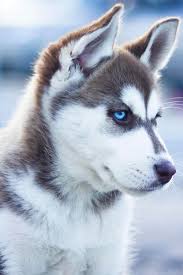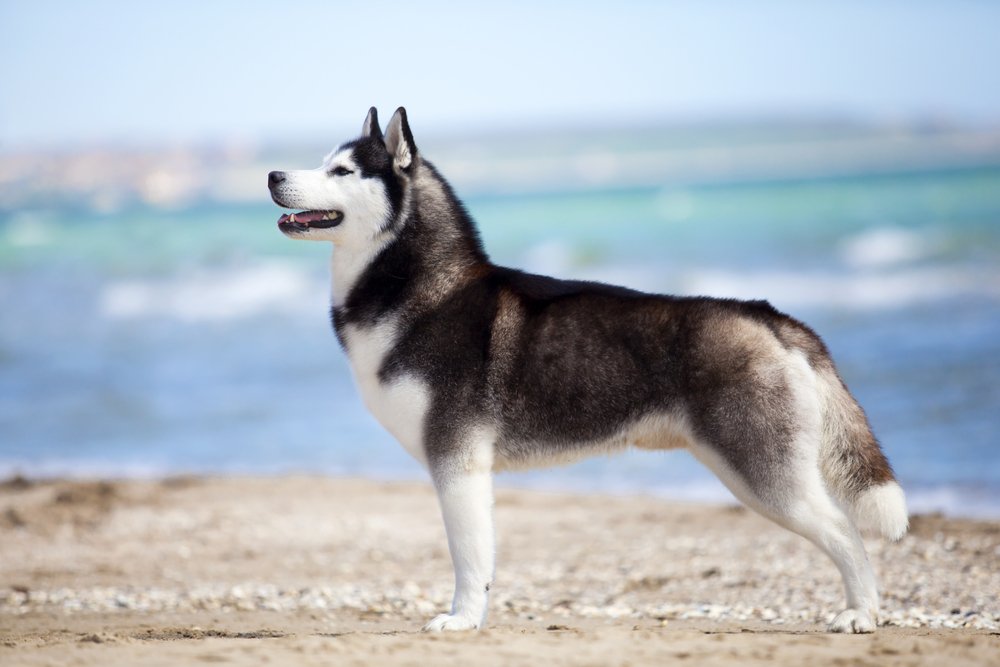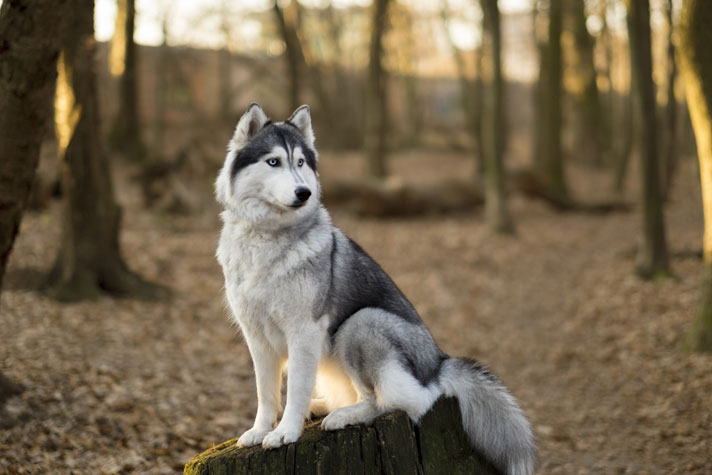The Siberian Husky is a medium-sized working dog breed. The breed belongs to the Spitz genetic family. It is recognizable by its thickly furred double coat, erect triangular ears, and distinctive markings, and is smaller than a very similar-looking dog, the Alaskan Malamute.
Siberian Huskies originated in Northeast Asia where they are bred by the Chukchi people for sledge-pulling, guarding and companionship. It is an active, energetic, resilient breed, whose ancestors lived in the extremely cold and harsh environment of the Siberian Arctic. William Goosak, a Russian fur trader, introduced them to Nome, Alaska during the Nome Gold Rush, initially as sledge dogs.
History
The original sledge dogs bred and kept by the Chukchi were thought to have gone extinct, but Benedict Allen, writing for Geographical magazine in 2006 after visiting the region, reported their survival. His description of the breeding practised by the Chukchi mentions selection for obedience, endurance, amiable disposition, and sizing that enabled families to support them without undue difficulty.

With the help of Siberian Huskies, entire tribes of people were able not only to survive but to push forth into terra incognita.
The Siberian Husky, Samoyed, and Alaskan Malamute are all breeds directly descended from the original sledge dog. It is thought that the term “husky” is a corruption of the nickname “Esky” once applied to the Eskimo and subsequently to their dogs.
Dogs from the Anadyr River and surrounding regions were imported into Alaska from 1908 (and for the next two decades) during the gold rush for use as sledge dogs, especially in the “All-Alaska Sweepstakes,” a 408-mile (657-km) distance dog sledge race from Nome, to Candle, and back. Smaller, faster and more enduring than the 100- to 120-pound (45- to 54-kg) freighting dogs then in general use, they immediately dominated the Nome Sweepstakes. Leonhard Seppala, the foremost breeder of Siberian Huskies of the time, participated in competitions from 1909 to the mid-1920s.
On February 3, 1925, Gunnar Kaasen was first in the 1925 serum to run to Nome to deliver diphtheria serum from Nenana, over 600 miles to Nome. This was a group effort by several sledge-dog teams and mushers, with the longest (264 miles or 422 km) and the most dangerous segment of the run covered by Leonhard Seppala and his sledge team lead dog Togo. The event is depicted in the 2019 film Togo and is also loosely depicted in the 1995 animated film Balto, as the name of Gunnar Kaasen’s lead dog in his sledge team was Balto, although unlike the real dog, Balto the character was portrayed as half wolf in the film. In honour of this lead dog, a bronze statue was erected at Central Park in New York City. The plaque upon it is inscribed,
“Dedicated to the indomitable spirit of the sledge dogs that relayed antitoxin six hundred miles over rough ice, across treacherous waters, through Arctic blizzards from Nenana to the relief of stricken Nome in the winter of 1925. Endurance · Fidelity · Intelligence.
In 1930, the exportation of the dogs from Siberia was halted. The same year saw recognition of the Siberian Husky by the American Kennel Club. Nine years later, the breed was first registered in Canada. The United Kennel Club recognized the breed in 1938 as the “Arctic Husky,” changing the name to Siberian Husky in 1991. Seppala owned a kennel in Nenana before moving to New England, where he became partners with Elizabeth Ricker. The two co-owned the Poland Springs kennel and began to race and exhibit their dogs all over the Northeast.

As the breed was beginning to come to prominence, in 1933 Navy Rear Admiral Richard E. Byrd brought about 50 Siberian Huskies with him on an expedition in which he hoped to journey around the 16,000-mile coast of Antarctica. Many of the dogs were trained at Chinook Kennels in New Hampshire. Called Operation Highjump, the historic trek proved the worth of the Siberian Husky due to its compact size and greater speeds. Siberian Huskies also served in the United States Army’s Arctic Search and Rescue Unit of the Air Transport Command during World War II. Their popularity was sustained into the 21st century. They were ranked 16th among American Kennel Club registrants in 2012, rising to 14th place in 2013.
Siberian huskies gained in popularity with the story of the “Great Race of Mercy,” the 1925 serum run to Nome, featuring Balto and Togo. Although Balto is considered the more famous, being the dog that delivered the serum to Nome after running the final 53-mile leg, it was Togo who made the longest run of the relay, guiding his musher Leonhard Seppala on a 91-mile journey that included crossing the deadly Norton Sound to Golovin.
In 1960, the US Army undertook a project to construct an under the ice facility for defence and space research, Camp Century, part of Project Iceworm involved a 150+ crew who also brought with them an unofficial mascot, a Siberian Husky named Mukluk.
Huskies were extensively used as sledge dogs by the British Antarctic Survey in Antarctica between 1945 and 1994. A bronze monument to all of BAS’s dog teams sits outside its Cambridge headquarters.
